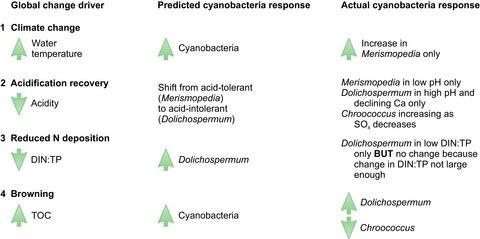当前位置:
X-MOL 学术
›
Glob. Change Biol.
›
论文详情
Our official English website, www.x-mol.net, welcomes your feedback! (Note: you will need to create a separate account there.)
Global changes may be promoting a rise in select cyanobacteria in nutrient-poor northern lakes.
Global Change Biology ( IF 11.6 ) Pub Date : 2020-05-23 , DOI: 10.1111/gcb.15189 Erika C Freeman 1 , Irena F Creed 2 , Blake Jones 3 , Ann-Kristin Bergström 4
Global Change Biology ( IF 11.6 ) Pub Date : 2020-05-23 , DOI: 10.1111/gcb.15189 Erika C Freeman 1 , Irena F Creed 2 , Blake Jones 3 , Ann-Kristin Bergström 4
Affiliation

|
The interacting effects of global changes—including increased temperature, altered precipitation, reduced acidification and increased dissolved organic matter loads to lakes—are anticipated to create favourable environmental conditions for cyanobacteria in northern lakes. However, responses of cyanobacteria to these global changes are complex, if not contradictory. We hypothesized that absolute and relative biovolumes of cyanobacteria (both total and specific genera) are increasing in Swedish nutrient‐poor lakes and that these increases are associated with global changes. We tested these hypotheses using data from 28 nutrient‐poor Swedish lakes over 16 years (1998–2013). Increases in cyanobacteria relative biovolume were identified in 21% of the study sites, primarily in the southeastern region of Sweden, and were composed mostly of increases from three specific genera: Merismopedia , Chroococcus and Dolichospermum . Taxon‐specific changes were related to different environmental stressors; that is, increased surface water temperature favoured higher Merismopedia relative biovolume in low pH lakes with high nitrogen to phosphorus ratios, whereas acidification recovery was statistically related to increased relative biovolumes of Chroococcus and Dolichospermum . In addition, enhanced dissolved organic matter loads were identified as potential determinants of Chroococcus suppression and Dolichospermum promotion. Our findings highlight that specific genera of cyanobacteria benefit from different environmental changes. Our ability to predict the risk of cyanobacteria prevalence requires consideration of the environmental condition of a lake and the sensitivities of the cyanobacteria genera within the lake. Regional patterns may emerge due to spatial autocorrelations within and among lake history, rates and direction of environmental change and the niche space occupied by specific cyanobacteria.
中文翻译:

全球变化可能正在促进营养不良的北部湖泊中某些蓝细菌的上升。
预计全球变化的相互作用(包括温度升高,降水变化,酸化降低和溶解的有机物向湖泊的负荷增加)将为北部湖泊的蓝细菌创造有利的环境条件。但是,蓝细菌对这些总体变化的反应是复杂的,即使不是矛盾的。我们假设在瑞典营养贫乏的湖泊中,蓝细菌的绝对和相对生物量(总和特定属)都在增加,而这些增加与全球变化有关。我们使用了16年(1998年至2013年)来自28个营养不良的瑞典湖泊的数据检验了这些假设。在21%的研究地点中,主要是在瑞典东南部地区,发现了蓝藻相对生物量的增加,Merismopedia,色球菌和Dolichospermum。分类单元特定的变化与不同的环境压力有关。也就是说,增加的表面水的温度有利于更高Merismopedia在具有高的氮与磷的比例低pH湖泊相对biovolume,而酸化回收有统计学相关的增加的相对biovolumes色球藻和Dolichospermum。此外,增加的溶解性有机物负荷被确定为抑制球菌和Dolichospermum的潜在决定因素晋升。我们的发现突出表明,特定的蓝细菌属受益于不同的环境变化。我们预测蓝细菌患病风险的能力需要考虑到湖泊的环境条件和湖泊中蓝细菌属的敏感性。区域格局可能由于湖泊历史内,湖泊历史之间,环境变化的速率和方向以及特定蓝细菌所占据的生态位空间之间的空间自相关而出现。
更新日期:2020-05-23
中文翻译:

全球变化可能正在促进营养不良的北部湖泊中某些蓝细菌的上升。
预计全球变化的相互作用(包括温度升高,降水变化,酸化降低和溶解的有机物向湖泊的负荷增加)将为北部湖泊的蓝细菌创造有利的环境条件。但是,蓝细菌对这些总体变化的反应是复杂的,即使不是矛盾的。我们假设在瑞典营养贫乏的湖泊中,蓝细菌的绝对和相对生物量(总和特定属)都在增加,而这些增加与全球变化有关。我们使用了16年(1998年至2013年)来自28个营养不良的瑞典湖泊的数据检验了这些假设。在21%的研究地点中,主要是在瑞典东南部地区,发现了蓝藻相对生物量的增加,Merismopedia,色球菌和Dolichospermum。分类单元特定的变化与不同的环境压力有关。也就是说,增加的表面水的温度有利于更高Merismopedia在具有高的氮与磷的比例低pH湖泊相对biovolume,而酸化回收有统计学相关的增加的相对biovolumes色球藻和Dolichospermum。此外,增加的溶解性有机物负荷被确定为抑制球菌和Dolichospermum的潜在决定因素晋升。我们的发现突出表明,特定的蓝细菌属受益于不同的环境变化。我们预测蓝细菌患病风险的能力需要考虑到湖泊的环境条件和湖泊中蓝细菌属的敏感性。区域格局可能由于湖泊历史内,湖泊历史之间,环境变化的速率和方向以及特定蓝细菌所占据的生态位空间之间的空间自相关而出现。


























 京公网安备 11010802027423号
京公网安备 11010802027423号